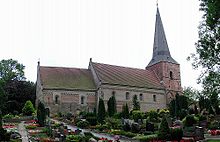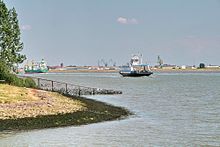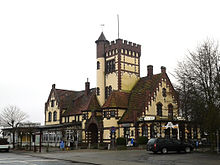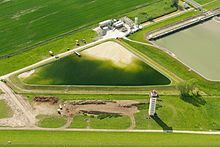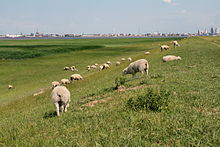Blinking
|
Blinking
City of Nordenham
Coordinates: 53 ° 32 ′ 0 ″ N , 8 ° 32 ′ 0 ″ E
|
||
|---|---|---|
| Height : | 0 m above sea level NN | |
| Residents : | 2750 | |
| Incorporation : | March 27, 1933 | |
| Postal code : | 26954 | |
| Area code : | 04731 | |
|
Location of Blexen in Lower Saxony |
||
Blexen is a district of the Lower Saxon town of Nordenham in the northeast of the Wesermarsch district on the Weser estuary (across from Bremerhaven ), where more than 2,750 people live.
history
First mention
Blexen was first mentioned in a document as Pleccateshem (home of lightning bolts) in 789 on the occasion of the death of Bishop Willehad . At the time, Blexen was still separated from the mainland by the Heete river , on an island. The St. Hippolytus Church became a pilgrimage church over the next few centuries . On April 23, 1189, eleven sailing ships set out from Blexen to take part in the Third Crusade . The ships came as far as Portugal and the crews took part in the battles for the city of Silves . The ships sailed on to Marseilles , after which their track is lost. A document about the trip was discovered in 1989 in Blex Church.
middle Ages
In the Middle Ages, Blexen belonged to the autonomous Frisian municipality of Rüstringen , the terra Rustringie . Outwardly, the regional municipalities were represented by the redjeven . In June 1220, 16 representatives from Rüstringen signed a contract with the city of Bremen in order to increase legal security and regulate trade. Thancte de Blekence (Blexen) also belonged to them .
In 1318 a market in Blexen was first mentioned. In 1400 the Blex church had to be left to the people of Bremen , who fought against the Likedeelers (including Klaus Störtebeker ) and rebellious Frisian Hovetlinge . The Butjadinger chiefs rose up against the Bremen people and in turn used the churches as fortifications, including the Blex chief Egge Herings , who was defeated by the Bremen people in 1419.
At the end of the 15th century Butjadingen came under the influence of Count Edzard I of East Frisia . As part of the Saxon feud , the united dukes of the Duchy of Braunschweig and Lüneburg and the Count of Oldenburg attacked Edzard and Butjadingen was conquered by them in January 1514 . Oldenburg initially received the Stadland with Esenshamm and Abbehausen as Allodium , in 1517 Count Johann V of Oldenburg had to take the area as a fiefdom from Duke Heinrich the Younger of Braunschweig-Wolfenbüttel . Butjadingen was divided among the Guelph dukes. The Welfs set up a block jump at Blexen . A Guelf rulership center was supposed to be built in Blexen in order to collect customs duties for the princes and to administer Butjadingen. But after a failed uprising by the Butjadingen farmers in 1515, the Guelph dukes gradually sold their property to the Oldenburg count , so that Butjadingen finally became Oldenburg in 1523. The count exercised national rule over the newly created castle in Ovelgönne .
Early modern age
With its high spire, the Blex Church has been a sea mark since 1566 . In the same year Count Anton I acquired the ferry house and the "Spieker" from Blexen, which were used for the ferry connection between the markets of Blexen and Lehe , for 200 thalers from the local Vogt, who had come into possession of the ferry justice through the Reformation . The church originally operated the Blexer Ferry, probably since the Middle Ages, to bring goods and parishioners from one side of the Weser to another.
The Christmas flood of 1717 claimed 800 victims in the four parishes Abbehausen, Atens, Blexen and Esenshamm. The parish of Blexen lost 20% of its inhabitants.
French period 1810–1813
In 1813 the population of the West-Phalian-East Frisian Landwehr rose against Napoleon's French troops . On March 17, 1813, gunners captured the Blexer Schanze of the French. As a result, riots broke out as local residents were accused of collaborating with the French. Only a vigilante initiative initiated by the Blexer pastor was able to restore order. On March 25th, French soldiers arrived in Blexen and retook the fort. The commander of the German gunners, Lübbe Eylers from Zetel , was shot immediately, the rest of them locked up. The next morning, eleven men were executed in the Blexer Kirchhof, some of them civilians. The fort remained in French hands until November 25, when it surrendered to Russian troops. A memorial stone on the church commemorates this event.
Modern times
In 1878 the first telephone in the Grand Duchy of Oldenburg was put into operation at the Blexen post office . It connected the station with the telegraph office in Nordenham . At the time of the great emigration from Bremerhaven at the end of the 19th century, Blexen was also jokingly referred to as “the last village before America”.
20th century
In the course of the Oldenburg administrative reform, Blexen lost its independence on March 27, 1933 and was incorporated into the city of Nordenham.
From August 13, 1941, a work detachment of Soviet prisoners of war was sent to Blexen from the prisoner-of-war main camp 310 (XD) in Wietzendorf / Lüneburg Heath. It initially had the command number 23 X D, from December 1, 1941 it was administratively taken over by the Stalag X C in Nienburg and continued under the number 5134 XC. A large number of the Soviet prisoners died in 1941/42 as a result of inadequate nutrition, cold and exhaustion from hard labor. The exact number and identity of the dead, causes of death and other circumstances can now be researched using the personal documents available from the former Wehrmacht information center (ID cards for prisoners) and are currently the subject of further research.
Culture and sights
- The Romanesque St. Hippolytus Church from the 12th century with the Münstermann altar was a destination for pilgrimages in the Middle Ages.
- The St. Willehad fountain was built in 1875 in the cemetery at St. Hippolytus Church made of sandstone in the neo-Gothic style as a memorial for Bishop Willehad , who died in Blexen in 789
- The former station building at the ferry terminal was built in 1907.
- The Blexer Deich allows a view of the sea-going waters of the Weser and is the contact point for visitors on the left bank of the Weser at the Windjammer Parade ( Sail ) in Bremerhaven , which takes place every five years .
Sports
- Blexer Turnerbund von 1907 eV : gymnastics, gymnastics, health sports, swimming, aqua fitness, hiking, table tennis, handball, athletics, step aerobics, badminton, tennis, Taekwon Do, triathlon, soccer
Regular events
Turnerball annually on the second Saturday in November, summer games, North Sea Cup tournament (handball) always Ascension, North Sea Cup tournament (tennis) in September
Economy and Infrastructure
Aviation
On September 29, 1929, the water sea flight company was founded with headquarters in Blexen. The goal was to launch seaplanes from Blexen to New York . After the construction of an airport building and a pontoon system , the airport was officially opened on July 15, 1928, but only with daily flights to Helgoland . Later the mail planes of the ships Bremen and Europa landed here . The former administration building for the airport has been preserved and now houses a senior citizens' center.
A secret production facility for seaplanes was set up at Volkers . In the buildings disguised as farmhouses, the planes of the two German aircraft carriers, which were supposed to be in Bremerhaven's north port, were also to be serviced. However, no seaplane was ever built or a carrier aircraft serviced. The course of the Second World War had ruined these plans. Towards the end of the war, Weser-Flugzeugbau, based in Einswarden , relocated part of its production to the “farms”. Only locals were employed as workers. In the post-war period after the Second World War in Germany , the buildings became the property of the Weser metal industry . This company made household items from war materials - pots and strainers from steel helmets, coffee pots from gas mask containers. After the company went bankrupt, the Bremen company Bachmann took over the halls as a grain store in 1992 . For this purpose, the hall walls were clad with wood so that the grain could first be stored in sacks and later as bulk goods. After the grain store was abandoned, the wooden boards were removed again and sold cheaply to self-collectors. The municipal employment company (KOMBEG) was founded in 1992 to further qualify the unemployed for new tasks. Since the end of KOMBEG in 2003, the Employment Agency has carried out further training measures there.
Floating dock construction
A bathing beach was set up in 1954 on the Vordeich area, which had been washed up for the airfield, with a view over the Weser to Bremerhaven. But as early as 1956, the area that was cut off for a floating dock yard for the Gutehoffnungshütte (GHH) right next to the ferry terminal was halved. In 2004, a large trade show entitled "Nordvision" was held on the site, which has now been cleared. The remaining area of the beach was lost from 1967 when the industrial company Kronos Titan settled .
From 2011, efforts were made on the former site of Schwimmdockwerft a supplier plant for offshore wind farms of Dillinger Hütte to build, which should provide an investment of 135 million euros on 21 ha 300 jobs. 300 to 400 meter long production halls were to be built parallel to the dike. The plans have now been implemented. On September 18, 2014, the Blexer Monopile plant was officially opened. It operates under the name of Steelwind Nordenham GmbH and is based in Blexen. The total investment was around 175 million euros. The plant is expected to reach full capacity by the end of 2016.
traffic
- Despite the Weser Tunnel south of Nordenham, which opened in 2004, there is still the Bremerhaven – Nordenham Weser ferry , which can be reached via the 212 federal highway . After an ore freighter rammed the Blexen pier on June 24, 2016 and severely damaged it, the ferry service was interrupted. A replacement bus service through the Weser Tunnel was set up for the transport of people.
The ferry service resumed on September 16, 2016. - Blexen has been the terminus of the Hude – Blexen railway since 1904 . The station building erected at the ferry terminal in 1907 is currently used for catering. The Nordenham-Blexen section has only been used as a port access and industrial track since the cessation of passenger traffic on March 31, 1980. The route between Nordenham-Friedrich-August-Hütte and Blexen is no longer in operation, but will initially only be reactivated for freight traffic.
- The Blexen airfield is suitable for gliders and small powered aircraft. There is also a possibility to start model airplanes directly on the premises.
Personalities
- Menno Hanneken (1595–1671), Lutheran theologian and philologist
- Klaus Dede (1935–2018), journalist and writer
- Roy Uwe Ludwig Horn (1944–2020), part of the magician duo Siegfried and Roy
- Jürgen Rieger (1946–2009), lawyer and NPD politician
literature
- Klaus Dede : Ten German men. Atelier in the farmhouse, ISBN 3-881-32298-1 (Documentation about the shooting of the ten Blexers by Napoléon's troops)
- Wolfgang Günter u. a .: Nordenham. The story of a city , ed. commissioned by the city of Nordenham by Eila Elzholz, Isensee-Verlag, Oldenburg 1993, ISBN 3-89598-153-2 .
- Eduard Krüger: The ferries on the Jade and the Weser estuary (Oldenburger Balkenschild: Kleine Hefte 29 + 30), Oldenburg 1967.
Web links
- Claas Tatje: Industrial Park Blexen: The poison from Nordenham . In: Zeit.de . May 24, 2017. Retrieved September 6, 2017.
Individual evidence
- ↑ Cf. Carsten Roll, From 'asega' to 'redjeven'. On the constitutional history of Friesland in the Middle Ages , in: Concilium medii aevi 13 (2010), pp. 187–221. As a PDF online
- ^ Heinrich Schmidt, The area of Nordenham in the Middle Ages and the Reformation , in: Wolfgang Günther (among others), Nordenham. History of a City , ed. on behalf of the city of Nordenham by Eila Elzholz, Oldenburg 1993, pp. 81–160, p. 100. The source is edited: Bremer Urkundenbuch I, no. 119.
- ^ Heinrich Schmidt, The area of Nordenham in the Middle Ages and the Reformation , in: Wolfgang Günther (among others), Nordenham. History of a City , ed. on behalf of the city of Nordenham by Eila Elzholz, Oldenburg 1993, pp. 81-160, pp. 145f.
- ↑ Gerd Steinwascher: The Elsflether Weserzoll and its significance for the Oldenburg history . In: Oldenburg landscape (ed.): Lectures of the Oldenburg landscape . tape 33 . Isensee, Oldenburg 2005, p. 7 .
- ↑ Eduard Krüger, The ferries on the Jade and the mouth of the Weser (Oldenburger Balkenschild: Kleine Hefte 29-30), Oldenburg 1967, p. 12f.
- ↑ Cf. Rosemarie Krämer, The History of the City of Nordenham from the 16th to the 19th Century , in: Wolfgang Günther (among others), Nordenham. History of a City , ed. on behalf of the city of Nordenham by Eila Elzholz, Oldenburg 1993, pp. 161-330, pp. 193f.
- ↑ Cf. Wolfgang Günther, Blexen and Nordenham in the 19th and 20th centuries , in: Wolfgang Günther (and others), Nordenham. History of a City , ed. on behalf of the city of Nordenham by Eila Elzholz, Oldenburg 1993, pp. 161-330, pp. 193f.
- ^ Blexen parish
- ↑ https://www.nwzonline.de/wesermarsch/wirtschaft/willehad-brunnen-wieder-originalgetreu_a_8,2,3218966621.html
- ↑ 53 ° 32 ′ 26.7 ″ N , 8 ° 30 ′ 33.4 ″ E Location of the hangars disguised as farms near the village of Volkers
- ↑ the former administration building
- ↑ a b Lieutenant Captain a. D. Helmut Krummel, Schiffdorf
- ↑ Oldenburgische Wirtschaft , No. 10 (from October 2014), page 16.
- ^ Nordwest-Zeitung Wesermarsch , accessed on April 2, 2015
- ↑ Peter Kleinort: Weser business is out of business for a longer period of time · Pier in Blexen badly damaged · Costs in the millions · Replacement bus service . In: Daily port report of July 21, 2016, p. 15
- ↑ https://www.nwzonline.de/wesermarsch/wirtschaft/neues-leben-auf-alter-bahnstrecke_a_31,2,1988098548.html
- ^ Blexen airfield

